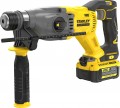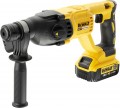Impact energy
The energy transmitted by the perforator to the material being processed upon impact; the higher this indicator, the stronger and more powerful each individual blow.
First of all, we recall that the energy of impacts is directly related to their frequency: an increase in frequency leads to a decrease in energy. Therefore, for models where the number of strokes can be adjusted, this paragraph usually gives the maximum energy achieved at the minimum speed of operation.
In general, higher impact energy improves efficiency when working with hard, stubborn materials, but requires more motor power (especially if it has to be combined with a high frequency). Therefore, it is worth choosing according to this parameter, taking into account specific tasks. So, for occasional use in everyday life, an energy of 2 J or less is enough, for home repair work of medium intensity, at least 3 J is desirable; a power of
4 J or more is already considered high; and in some industrial-grade perforators, this figure can reach 30 J.
Max. torque
The maximum torque developed by the rotary hammer.
Without going into too much detail, torque can be described as the working force of a tool. For drilling with impact, this indicator is not of fundamental importance — we recall that the rotation of the nozzle in this mode performs an auxiliary function, and the key parameters are the frequency and energy of impacts. But with traditional drilling, without impact, the torque directly determines the effectiveness of the tool. The higher it is, the more powerful the impact on the material being processed, and the larger the drilling diameter this model can provide. However tools with similar drilling diameter limits may differ in torque; in such cases, you should assume that more operating force requires a more powerful motor and affects the cost, but it contributes to reliability and provides additional guarantee in case of some abnormal situations.
Concrete drilling max. ⌀
The maximum tool diameter that can be used with a rotary hammer when drilling in concrete. See "Maximum drilling diameter in wood" for details.
Max. hole saw ⌀
The maximum tool diameter that can be used with a rotary hammer when drilling with a hollow core. Crowns are used to create holes of large diameter (from 40 mm) in hard materials such as reinforced concrete and stone. See "Maximum drilling diameter in wood" for details on the maximum diameter.
Functions
—
Soft start. A function that provides a smooth spin-up of the tool motor, with relatively little acceleration. This is achieved by limiting the starting current. Without such a limit, the current drawn by the motor at the time of starting can be quite high, causing the motor to start very abruptly, which increases the risk of letting go of the tool. In addition, current surges can lead to overloads in the network used for power. Soft start allows you to eliminate these phenomena to some extent. Note that it only applies to mains powered models.
—
Speed controller. Electronic limiter for the maximum speed of the tool attachment. This is implemented using a rotary switch on the tool body, turning it clockwise increases the maximum allowable speed, against — reduces it, which allows you to take into account the characteristics of the materials that need to be drilled or gouged.
—
Maintain momentum. The presence of an electronic adjustment system that automatically adjusts the rotation speed depending on the diameter of the working tool and the type of material. At the same time, the regulator maintains a constant speed regardless of the load — by changing the power supplied to the tool. Automatic adjustment increases the quality of processing and productivity, and also increases the life of both the working tool and the hammer itself, ensuring optimal operati
...on.
— Soft blow(economy mode). A special mode of operation in which the impact energy and rotational speed provided by the rotary hammer are reduced. This affects two things: firstly, the tool acts less intensively on the material being processed, and secondly, wear and energy consumption are reduced. The first feature will be relevant when processing fragile materials that can be damaged by too powerful chiselling; the second — when working with soft materials, which lend themselves well to even not very strong impact.
— Anti-vibration system. The system for suppressing vibrations transmitted from the operating unit to the operator. Strong vibrations impair the accuracy of work, and also lead to rapid fatigue; vibration protection reduces these effects. It is used mainly in expensive professional models designed for long-term operation.
— Safety clutch. Mechanical safety system that protects the hammer from breakage, and the operator from injury in case of jamming of the working tool in the material. When this happens in the drilling mode, the engine experiences critical loads that can very quickly disable it, and when chiseling, the hammer itself also starts to move, transmitting vibration to the operator’s hands. The safety clutch is set to a certain load level; when it is exceeded, it is destroyed, breaking the connection between the working tool and the perforator mechanisms.
— Power button lock. The ability to block the power button in the off and/or on state. In the first case, the lock provides protection against accidental pressing, and can also play the role of child protection — the lock button is usually quite tight, and a curious little child will not be able to press it. The second option is useful if you need to work for a long time without a break, and it is inconvenient to keep the power button pressed all the time.
— Brushless motor. The presence of a brushless (brushless) motor in an electric tool. Such motors are noticeably superior to traditional collector motors in terms of efficiency, which can significantly reduce energy consumption without sacrificing power; this is especially important for cordless tools (see "Power Source"), where this feature is predominantly found. In addition, brushless motors are quieter and produce virtually no sparks during operation, making them perfect for working in high fire hazard environments. Their main disadvantages are traditional — the complexity of the design and high price.
— Backlight. The perforator has its own lamp that illuminates the work area. This feature is useful if there is little natural light, and there is no way to install artificial light — for example, when working in cramped conditions.
— Reverse. The reverse function allows you to rotate the working tool of the rotary hammer in the opposite direction. This can be useful, for example, to release a drill stuck in the material.
— Synchronization with a smartphone. The ability to connect the instrument to a smartphone or other gadget (such as a tablet) via Wi-Fi or Bluetooth. Such a connection is usually used to adjust operating parameters such as speed or torque; doing this through a mobile application is often more convenient than through the controls on the instrument itself. And some models with this function also allow you to set password access: the tool simply will not respond to the start button until the correct password is entered on the control gadget.
— Built-in spirit level. Built-in device to control the angle at which the tool is located to the horizon. As in ordinary levels, the role of the scale in such devices is played by a sealed flask with marks applied to it, containing a brightly coloured liquid and an air spirit. By the position of this spirit relative to the marks, the position of the entire tool is determined — namely, its correspondence to the vertical, horizontal, or pre-set tilt angle (the latter option, however, is almost never found in the built-in levels). At the same time, purely hand tools usually provide a single-axis level that reacts only to deviation from the horizontal forward or backward, and models with the ability to mount on a rack (see below) can also have a circular level that controls compliance with the vertical and determines deviations from it in any direction.
— Carbon brush replacement indicator. The presence of a special indicator in the design of the perforator, signaling the need to replace the carbon brushes. Carbon brushes are located in the electric motor and are the most worn part of it, because. subject to constant friction during operation. When the brushes are worn beyond a critical level, the engine power drops, it starts to work intermittently, which can lead to unpleasant consequences up to tool breakage or even injury. And replacing the worn brushes themselves is much cheaper than changing the entire electric motor or even the entire tool.Batteries in set
Most modern power tools use replaceable batteries, and then this paragraph indicates the number of such batteries. Such tools can be equipped with several batteries, usually
2 batteries(
models with 1 battery are not widely used).
In addition, quite a few modern cordless tools come in a configuration colloquially known as a “carcass” — namely,
no batteries at all. This option is relevant mainly for two cases: if the user wants to choose a power source separately, at his own discretion, or if such a source is already on the farm. Regarding the second option, it is worth noting that many large manufacturers use universal batteries suitable for different types of branded power tools. So a battery, for example, from a previously purchased jigsaw or grinder may well be compatible with a rotary hammer of the same company.
Battery voltage
Operating voltage of the battery in a rotary hammer with appropriate power supply (see “Power source”). The more powerful the tool, the higher the battery voltage, as a rule. At the same time, this parameter is usually selected in such a way as to optimally match the characteristics of a particular model; therefore, in practice, voltage data may only be required when looking for a spare or additional battery. And the most popular models are
18 V cordless hammer drills.
Battery type
The model of a standard battery allows you to find out its characteristics in more detail, and also helps you understand what devices it is like and which one should be purchased in case of a replacement due to a malfunction or, if necessary, buy another similar one.
Compatible batteries
The name of the battery that is compatible with the device. It helps to buy a spare or find a suitable one in case of a breakdown of the main one.

